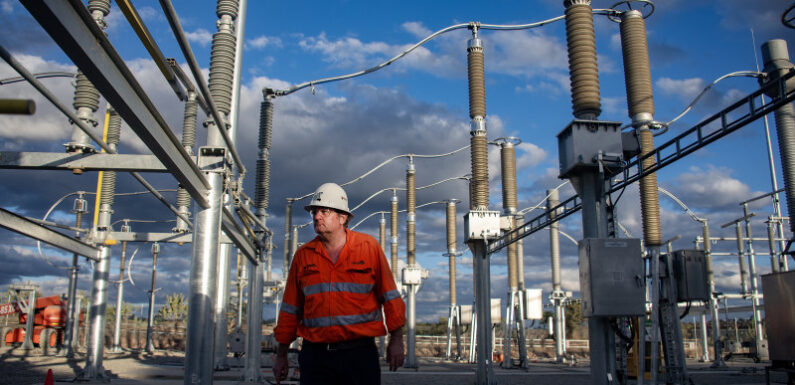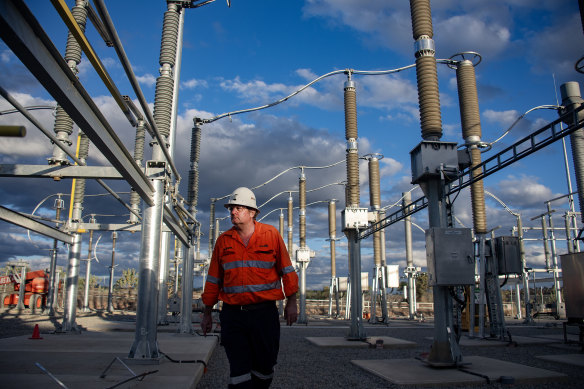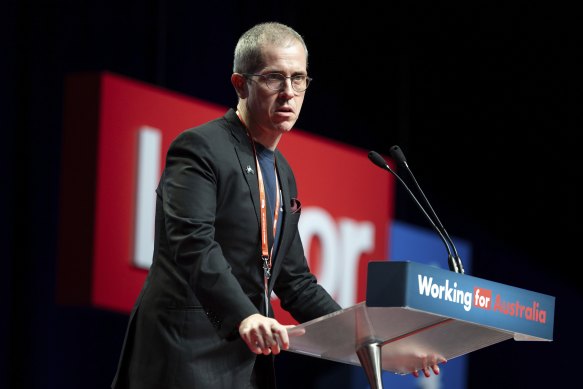
Save articles for later
Add articles to your saved list and come back to them any time.
A major union and industry group are calling for a specific migration pathway for electrical trades to plug a desperate shortfall of skilled workers needed in the transition to renewable energy.
Electrical Trades Union national secretary Michael Wright said both sides of politics had failed to find enough workers to meet Australia’s clean energy targets, and the Albanese government needed to “pull its finger out”, criticising a federal plan to beef up the quality of TAFE qualifications as a “niche response to a mass problem”.
A key union and an industry group want a special migration stream for electrical workers, so Australia can meet the demand for renewable energy.Credit: Brian Cassey
“The bipartisan failure that’s led to us being in this sort of crisis is going to inhibit the energy transition, and is going to mean we have to rely more on skilled migration than we should,” said Wright, who along with the National Electrical and Communications Association wants an industry stream for overseas workers to bolster the main goal of upskilling Australians.
NECA chief executive Oliver Judd said that to achieve Labor’s Powering Australia plan and electrifying the nation “there needs to be both targeted skilled migration and a significant increase in training services and facilities.”
The call comes ahead of the release of the government’s migration strategy, due within weeks, which Home Affairs Minister Clare O’Neil has flagged will add to the employment white paper, published on Monday, by fine-tuning the types of skills the economy needs.
A record, post-pandemic surge in net migration, fuelled by the return of international students, will force the government into a balancing act as the federal opposition stokes fears of a “big Australia” off the back of a crisis in housing supply.
ETU national secretary Michael Wright says governments have failed to provide skilled workers needed for the clean energy transition.Credit: Alex Ellinghausen
After celebrating the uptake of labour agreements between providers and unions to bring overseas workers into the haemorrhaging aged-care industry – with 6000 places now available under that stream – Immigration Minister Andrew Giles signalled his openness on other parts of the economy.
“The Albanese government will continue to assess and learn from the aged care industry labour agreement and seek to promote this approach where suitable,” Giles said.
”Immigration isn’t a silver bullet – but it will play a vital role in addressing workforce shortages across the Australian economy.
“The need to ensure a skilled workforce to deliver the energy transformation is front and centre in planning the transformation, including through the development of an energy workforce strategy.”
Wright stressed training and hiring locally had to be the priority, and, under the proposal, any employer who wanted to bring in overseas workers had to demonstrate a commitment to local recruitment. He also qualified no agreements should be used to drive down industry pay rates or conditions.
Judd said workers “must be provided the employment conditions to attract and retain them in Australia and deliver the quality outcomes needed.”
“We believe these will be highly sought after jobs that will encourage experienced workers from around the world to consider becoming Australians,” he said.
Electricians are also needed in the construction industry, where Wright acknowledged the industry migration model could potentially also apply, albeit with different conditions.
“We want to start with this in the transmission space, building the transmission links. As always, when you eat an elephant, you do it one bite at a time,” he said.
The Labor Party at its national conference in August resolved to create tripartite agreements between industry, unions and government for skilled migration where possible.
This year the government launched a scheme in which apprentices working in the renewable energy sector would receive $10,000 to help Australia meet its 2030 and 2050 emissions reduction targets.
Wright said due to a 58 per cent completion rate in apprenticeships, the industry would need an additional 20,000 apprenticeships starting every year to have enough skilled workers.
The government’s jobs road map includes a plan to upgrade the quality of vocational training to encourage TAFE students to sign up to “degree apprenticeship qualifications” to better equip them for careers in clean energy, among other in-demand fields.
But Wright said it was baffling the government would address a situation with major shortfalls “and go ‘we need to do something, we need to focus on what is really a niche area, it’s a niche response to a mass problem’” .
“The idea that TAFE, which has financially and culturally been undermined for 30 years, is suddenly going to be able to turn around and do this, is crazy,” he said.
Cut through the noise of federal politics with news, views and expert analysis from Jacqueline Maley. Subscribers can sign up to our weekly Inside Politics newsletter here.
Most Viewed in Politics
From our partners
Source: Read Full Article

